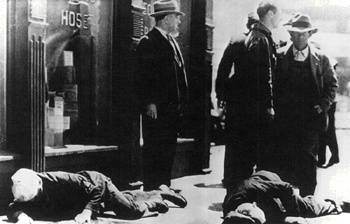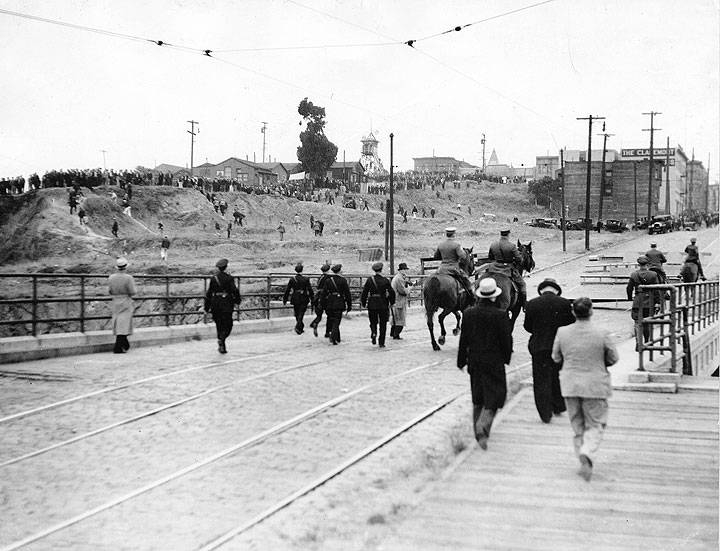The General Strike of 1934
Historical Essay
by Chris Carlsson
Strikers shot by police, July 5, 1934
Photo: San Francisco History Center, San Francisco Public Library
Police and strikers on Rincon Hill, July 10, 1934.
Photo: San Francisco History Center, San Francisco Public Library
| After Bloody Thursday (July 5, 1934), when police killed two strikers, twenty-one unions representing Teamsters, longshoremen and seamen voted to organize a general strike. They hoped to win higher wages, shorter hours, and union control of hiring halls. Despite exceptions from conservative union leadership in the Central Labor Committee keeping many workers at their jobs, vitriolic attacks from San Francisco’s newspapers, police and vigilante violence and break-ins against labor organizations, and threats of university student scab workers, over 150,000 workers around the Bay Area officially went on strike by July 16, 1934. Ultimately, the opposition weakened the strike and by July 20th, all unions involved had voted to return to work. Maritime workers gained partial victories on wages, hours, and hiring halls from an arbitrator's decision handed down months after the July strike, and the impetus towards worker organizing led to a major wave of unionization throughout San Francisco during the 1930s. |
After Bloody Thursday, the joint marine strike committee called for a general strike. Fourteen unions voted to support the call the next day, and the Teamsters voted to go out on July 12 if the strike remained unsettled. On Monday July 9 a crowd of 40,000 people solemnly filled Market Street in a funeral procession for the slain strikers.
Over the next week, momentum for a General Strike snowballed. The Central Labor Council, which had denounced the maritime strike leaders as communists in late May, scrambled to head off the General Strike by creating a Strike Strategy Meeting, an effort characterized by Sam Darcy as an effort "to kill the strike, not to organize it."
At 8 a.m. on Monday, July 16, the San Francisco General Strike officially began, involving around 150,000 workers around the Bay. But it had already been rolling along for a few days by then. Between July 11 and 14, over 30,000 workers went out on strike, including teamsters, butchers, laundry workers, and more; by July 12th 21 unions had voted to strike, most of them unanimously.
The newspapers coordinated a vitriolic attack on the strike. The Examiner ran a front page piece on July 16 with the headline General Strike in England Crushed When Government Took Control of Situation next to a front page editorial A Lesson From England. The Los Angeles Times picked up the theme and wrote "The situation in San Francisco is not correctly described by the phrase 'general strike'. What is actually in progress there is an insurrection, a Communist-inspired and led revolt against organized government..."
On Tuesday, July 17, National Recovery Administrator General Hugh S. Johnson gave a speech at UC Berkeley (where students had served as scab workers by the hundreds) in which he paid lip service to the labor's right of collective bargaining, but went on to declare the general strike "a threat to the community, a menace to the Government... civil war," brought on by subversive influences.
July 17 also began a reign of terror targeting suspected homes and meeting places of radicals, subversives, and communists, including the offices of the Marine Workers Industrial Union (60 were arrested for being present), the Communist Party Headquarters, the Ex-Servicemen's Headquarters on Valencia Street, and several private homes. Dozens of armed men burst in, clubbed people, and smashed furniture and equipment. Police "mopped up" behind them, arresting 300 "radicals" in one day.
Charles Wheeler, vice president of McCormick Steamship Line, said in speaking to the Rotary Club that day that the raids would start soon, intimating that the government had given its approval. Arrested radicals were subject to immigration status inquiries and deportation, another indication of federal involvement in the repression.
The General Strike began to weaken almost as soon as it began. On top of the violent attacks by vigilantes throughout the city, the conservative Central Labor Council's Strike Committee authorized so many exceptions that they dramatically undercut the General Strike. On the first day, they allowed municipal carmen (streetcar operators) to return to work, ostensibly because their civil service status might be jeopardized. The Chairman of the Labor Council was Edward Vandeleur, who was also president of the same Municipal Carmen, and had opposed the strike since the beginning.
The Ferryboatmen, the printing trades, electricians, and telephone and telegraph workers were never brought into the strike. Typographical workers and reporters continued to work on newspapers that spewed forth anti-strike propaganda. Labor Council leaders even went so far as to issue a work permit to striking sheet metal workers to return to their jobs in order to repair police cars.
President Roosevelt officially stayed aloof from the strike; his Labor Secretary Perkins cabled him that the General Strike Committee of Twenty-Five "represents conservative leadership."
By July 19th the General Strike Committee voted narrowly to end the Strike. On July 20th, the Teamsters voted to return to work, fearing that the Mayor's Committee of 500 and the Industrial Association would put strike-breakers on all the trucks in SF and leave the Teamsters without jobs.
This was the end for the Longshoremen and Seamen's strikes along the waterfront. They soon submitted to arbitration that ultimately led to partial victories on wages and hours, but the key issue of union control over hiring halls was lost to a formula that allowed for joint management of hiring halls with the shipping companies. But the unions got to pick the dispatchers, so they enjoyed control in fact if not by contract. And the strength of the maritime workers was far from broken. For instance, during the period January 1, 1937 to August 1, 1938, more than 350 small strikes and work stoppages occurred along the Pacific Coast.
READ MORE:
Strike! by Jeremy Brecher, South End Press: Boston, 1972.
American Labor Struggles by Samuel Yellen © 1936, Monad Press edition: New York, 1974.
The Labor Wars by Sidney Lens, Anchor/Doubleday: New York, 1974.
The Big Strike by Mike Quin, Olema Books: 1948.
On The Drumhead by Mike Quin, Daily People's World: San Francisco, 1948.
The Big Strike: A Pictorial History of the 1934 SF General Strike with a narrative by Warren Hinckle, Silver Dollar Books: Virginia City, Nevada, 1985.
<iframe src="https://archive.org/embed/SanFranc1934" width="640" height="480" frameborder="0" webkitallowfullscreen="true" mozallowfullscreen="true" allowfullscreen></iframe>
Pathe News coverage of early days of General Strike.
Video: Prelinger Archive
Open War in the Streets Newsreel
Silent footage of early weeks of strike


